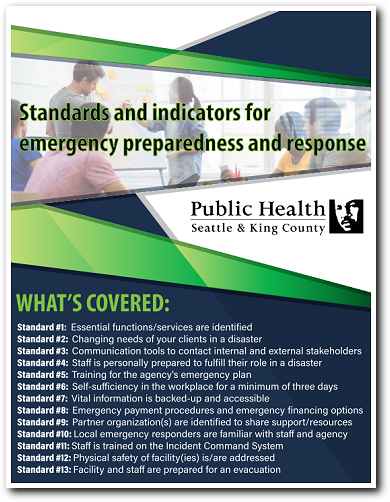Tools and resources for community-based and faith-based organizations
Standards and indicators for emergency preparedness and response
The thirteen standards that a community agency should work towards to become more prepared and resilient in the event of an emergency or disaster are outlined here with tools and resources to support community agencies in completing the standards.
Agencies will need to prioritize their plans based on the population served, identified essential services, and existing capacity. Not all standards and indicators will apply to every agency.
Resources to help your organization prepare
Social Vulnerability Index Maps:
What is Social Vulnerability?
Every community must prepare for and respond to hazardous events, whether a natural disaster like a tornado or a disease outbreak, or an anthropogenic event such as a harmful chemical spill. The degree to which a community exhibits certain social conditions, including its poverty, car ownership, or number of persons in households, may affect that community's ability to prevent human suffering and financial loss in the event of disaster. These factors describe a community's social vulnerability.
How can the SVI help communities be better prepared for hazardous events?
The SVI provides specific socially and spatially relevant information to help public health officials and local planners better prepare communities to respond to emergency events such as severe weather, floods, disease outbreaks, or chemical exposure.
The Social Vulnerability Index (SVI) helps state, local, and federal planning officials identify the locations of their most vulnerable populations. This work builds on research that examines vulnerability as a social condition, or a measure of the resilience of population groups when confronted by disaster. The SVI includes sociodemographic attributes, such as age, race, and economic status, to identify the relative social vulnerability of populations to the effects of natural or anthropogenic disasters.
- King County Social Vulnerability Index (SVI) Map (PDF, 24 Mb)
- SVI Supplement (PDF)
- Vulnerable & At-Risk Populations (VARP) Resource Guide
- VARP Webinar Flyer (PDF)
Tools from Public Health and the Vulnerable Populations Operations Workgroup
- Agency Emergency Plan Self-Assessment (PDF)
Take this assessment to see which standards your agency may want to prioritize.
- Tabletop Materials for Community and Faith-based Organizations
The following materials were designed to be used by organizations to test their level of preparedness:
- Exercise Guide – read this first! (PDF)
- Earthquake Tabletop Template (PowerPoint)
- Pandemic Flu Tabletop Template (PowerPoint)
- Severe Weather Tabletop Template (PowerPoint)
- Personal Preparedness Discussion (PDF)
- Improvement Plan Tracker (Excel)
Tools from partner agencies
- Ready Rating: American Red Cross
- CARD Agency Emergency Plan (PDF)
A guide for creating an agency emergency plan for your nonprofit agency.
- Disaster Mental Health for Emergency Response Teams (CERT)
- National Child Traumatic Stress Network -- Psychological First Aid
- FEMA National Incident Management System (NIMS)
- Create a Business Continuity Program
Software that walks an organization of any size through business continuity planning.
- WA Emergency Response Rules (WAC Chapter 296-824)
- ECHO Minnesota
Provides communication tools in multiple languages to public health and safety agencies during a crisis.

 Translate
Translate
